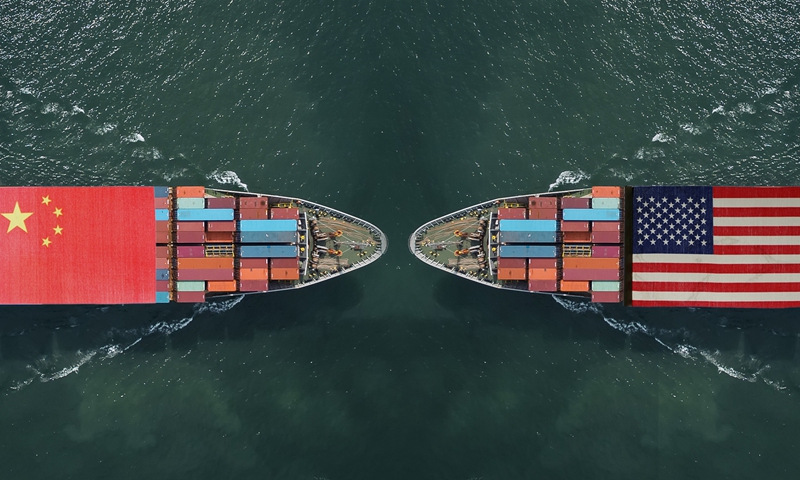Trade between China and the US soared by 28.7 percent year-on-year in US dollar terms in 2021, amounting to a staggering number of $755.6 billion, and US trade deficit with China further widened, Chinese customs data showed on Friday, maintaining strong growth momentum even with additional tariffs in place and bruising political tensions casting shadows on bilateral ties.
The number, which comes just one day ahead of the second anniversary of the signing of the phase-one trade deal, shows a strong complementarity between the world’s two largest economies, while it is also a demonstration of China’s striving to fulfill its commitments under the deal over the past two years, observers said.
According to Chinese customs data released on Friday, China’s export to the US increased by 27.5 percent over the whole year in 2021, while imports grew by 32.7 percent.
Moreover, the US maintained its place to be China’s third-largest trade partner following the ASEAN and the European Union. China-US trade volume was twice of China’s trade amount with its fourth-largest trade partner Japan – which was 2.4 trillion yuan.

China US Photo:Global Times
Widening US deficit
Friday’s figures point to maintained growth momentum from 2020, when trade between the world’s top two economies was back on a growth track, after a plunge in 2019 when bruising trade tensions clobbered bilateral imports and exports.
In particular, China’s trade surplus with the US was $39 billion in December and $396.5 billion for the whole of 2021, further widening from a surplus of $357.5 billion recorded in the first 11 months, according to the Global Times’ calculations.
The widening was in contrast with US ambitions to reduce the gap – one of the key motivations for former US president Donald Trump to launch the trade war against China. Most of the additional tariffs have remained in place under the Biden administration.
“The widening deficit proves that tariffs cannot solve any problem,” Gao Lingyun, an expert at the Chinese Academy of Social Sciences in Beijing, told the Global Times on Friday, calling on an effort for the removal of the tariffs as soon as possible.
A removal of additional tariffs has been the US business community’s wish. “We’d like to see the tariffs mutually reduced or eliminated entirely … US jobs were lost and higher costs for imported items due to tariffs cost the average household over $400 per year,” the US-China Business Council (USCBC) said in an interview with the Global Times via e-mail.
Gao Lingyun, an expert at the Chinese Academy of Social Sciences in Beijing, predicted that in 2022, it’s possible that China’s imports from the US might “surge on a large scale” as there are many deals “under negotiation,” while stressing that the purchases have to be based on fair prices and China’s own demands.
What’s next?
Ahead of the two-year anniversary, there are also growing discussions about the results of the phase-one agreement and the next step for the world’s two biggest economies.
Some in the US are asserting that China has failed to meet its target for purchases of US products and services, while many in China are pointing out the US’ escalating crackdown on Chinese firms and lingering tariffs and other restrictions, as well as uncontrollable external factors such as the pandemic.
In particular, the US crackdown on China’s technology sector has expanded from 5G to artificial intelligence and biotechnology, in a desperate attempt of the US to maintain its shaky tech dominance.
Chinese Ministry of Commerce spokesperson Shu Jueting said on Thursday that since the phase-one deal came into force, China has worked to overcome several unfavorable factors, including the COVID-19 pandemic, a global economic recession and supply chain disruptions, to push for the joint implementation of the deal.
“There is no doubt that the deal benefits both China and the US as well as the world … Trade teams of the two sides are maintaining normal communications and if there is any further information, we will release it promptly,” Shu said at a press conference held in Beijing on Thursday.
Twists and turns might continue, but trade can still be a buffer and cornerstone in China-US relations, observers said, while noting that first and foremost, China will firmly safeguard the interests of its firms and people.
China’s foreign trade in 2021. Graphic: Feng Qingyin/GT



